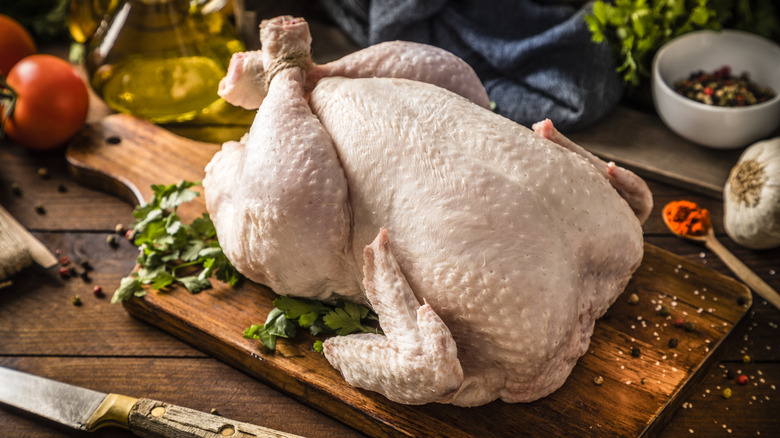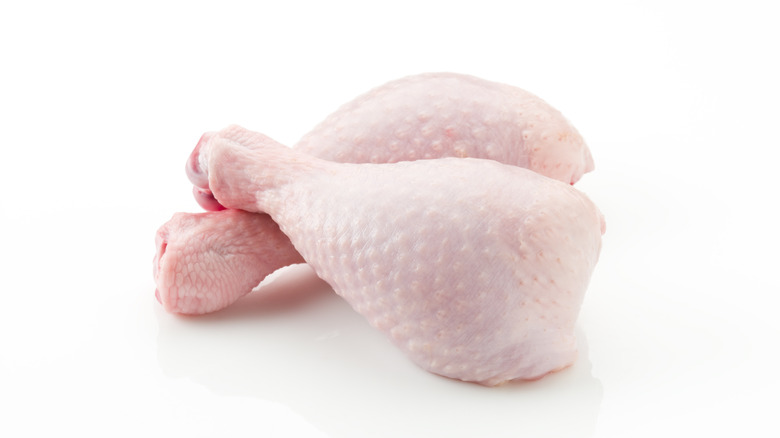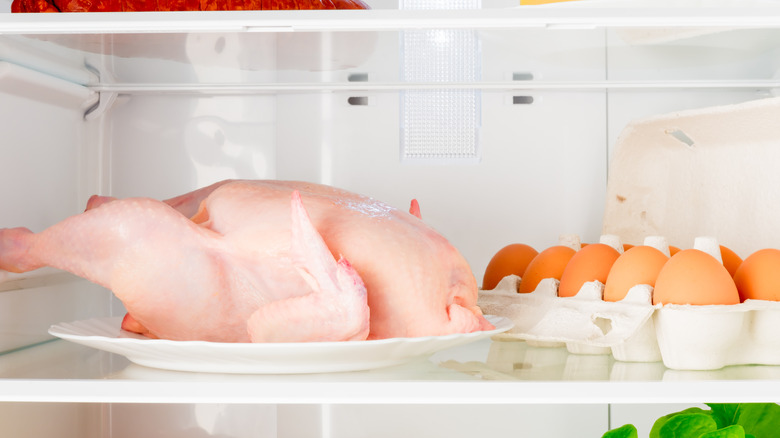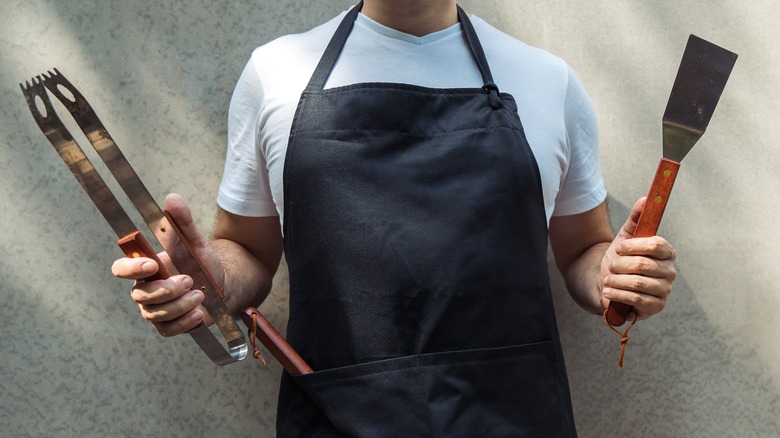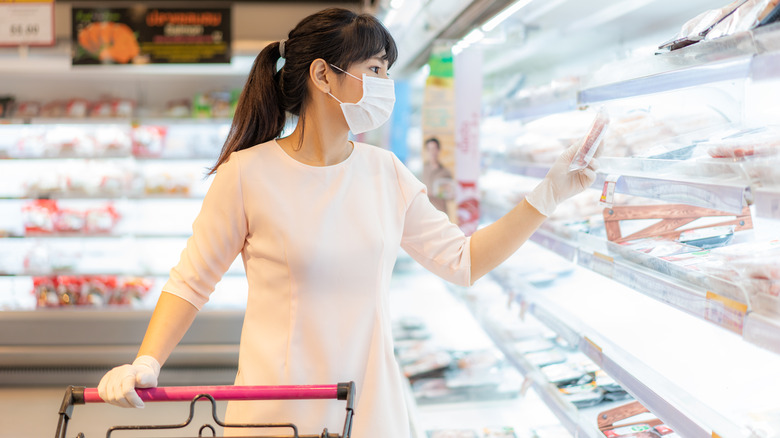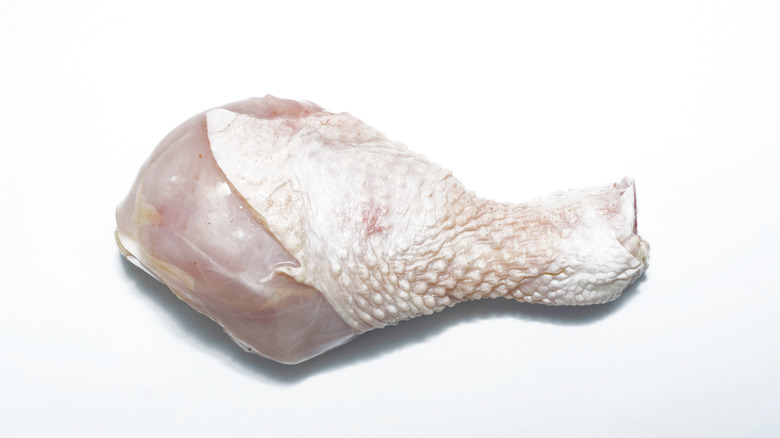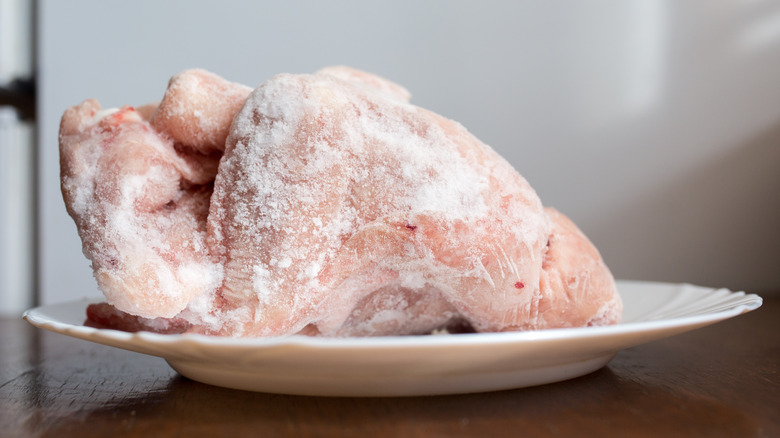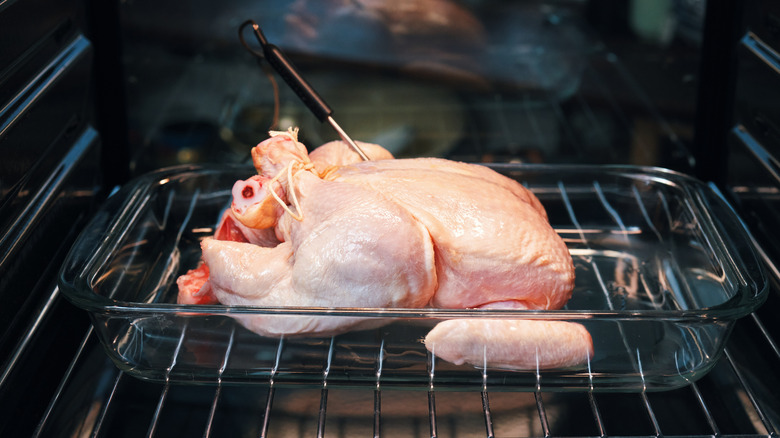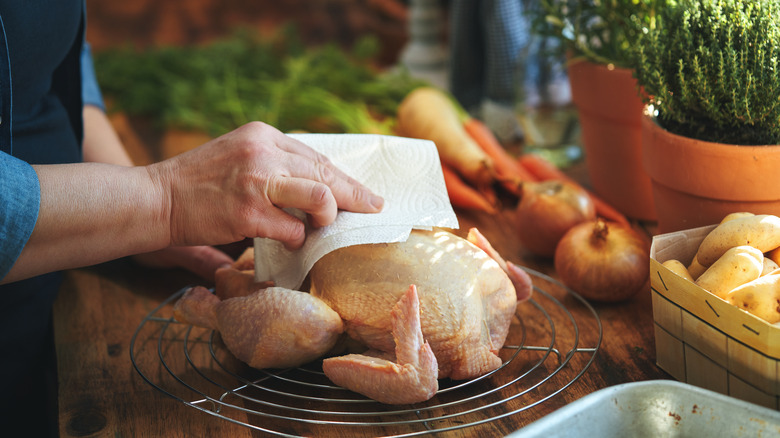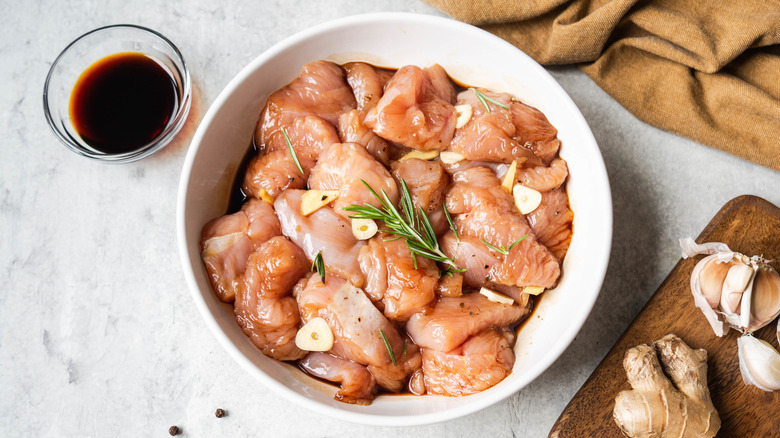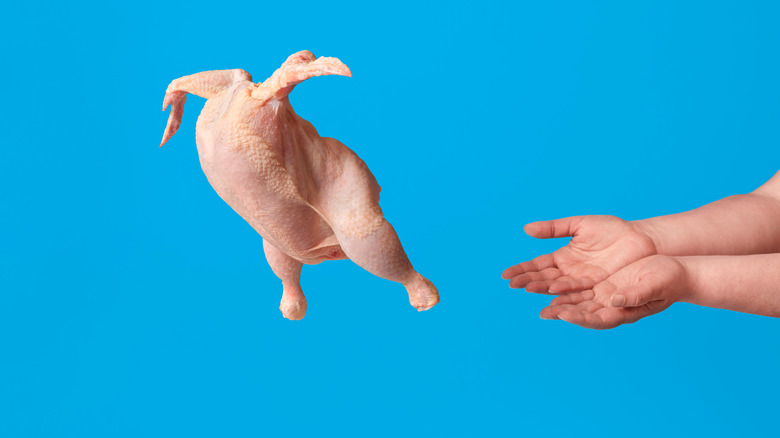10 Mistakes You Are Making With Raw Chicken
In 1970, the average person ate about 50 pounds of chicken annually. Today, according to Vox, that number is more than 100 pounds. Meanwhile, consumption of beef and pork is decreasing for a variety of reasons, including the introduction of more plant-based fare and the affordability of chicken. As chicken has become marketed more aggressively as a cheaper and healthier source of protein, it's become a staple of the American diet — and it's not going anywhere.
From a simple whole roast chicken to a not-so-simple Moroccan tagine, the options for cooking poultry are seemingly endless. While there are hundreds of recipes designed to elevate this humble bird, here are a few simple rules to follow in order to make sure your chicken is safe to eat and your kitchen remains sanitary. After all, raw chicken poses a serious health risk when it isn't prepared safely. When raw chicken juices are left on utensils and cooking surfaces like cutting boards, bacteria can spread. Avoid getting sick by taking a few simple precautions and cleaning thoroughly when you're finished working with chicken.
1. Washing raw chicken in the sink
You might think you're cleaning raw chicken even more effectively by rinsing it in the sink, but you're just splashing bacteria around instead. Salmonella infection, which is a serious health issue to be aware of when working with poultry, can spread through contaminated food or surfaces and make you sick. Salmonella can cause stomach cramps, diarrhea, and fever.
The Centers for Disease Control and Prevention estimates that salmonella causes about 1.35 million infections, 26,500 hospitalizations, and 420 deaths in the United States every year — and poorly prepared food is the main cause. If you want to avoid getting sick, it's best to keep your chicken away from the sink and isolated on a cutting board or designated preparation space. You can take cutting board cleanliness a step further by investing in a board with a juice canal function.
The most effective way to ensure that any bacteria has been killed is to simply cook your chicken. Chicken is safe to eat when it reaches an internal temperature of 165 F. You can check your chicken's temperature with a meat thermometer if you're unsure.
2. Storing chicken improperly in the refrigerator
No one likes reaching into the refrigerator to pull out a package of chicken and discovering it's been leaking all over the rest of the produce. Yuck! Chicken juices don't tend to stay in the package, and these fluids can contaminate other food.
If you don't want to toss your groceries and spend the afternoon disinfecting the fridge, store chicken in a plastic bag with a zip lock or a Tupperware container with a tightly fitting lid. You can use tongs to put the chicken in its container to make sure your chicken-juice-covered hands don't get all over the outside.
For additional safety, keep your wrapped-up chicken on the bottom shelf. Juices from the raw chicken can drip down on items like carrots that you plan to serve as a raw snack, and you might not even notice. Your refrigerator should maintain a temperature of 40 F in order to keep the chicken fresh and safe to eat. Put the chicken in immediately and cook within one or two days or freeze it. Raw chicken can stay frozen for nine months.
3. Cross-contaminating your untensils
If your cooking area is a delightful scene of chaos, great! There's nothing more beautiful than a kitchen filled with fresh produce and herbs. But be careful not to mix up utensils that have touched raw chicken with utensils you are using to chop up that delicious selection of baby greens for salad — you run the risk of making yourself or your dinner party sick from food-borne illnesses.
Some people color code their utensils and cutting boards to avoid confusion, but the best solution is to put aside all the utensils that have come into contact with raw chicken or chicken juice. Wash them after each use to prevent the spread of salmonella. And always spray your workspace with a disinfectant that will specifically kill viruses and bacteria once you are done working with raw chicken.
As microbiologist Gary Acuff told Eating Well, you should also use different utensils while cooking. He suggests using one set of tongs on meat that is still raw and then another set on meat that has been mostly cooked.
4. Putting it directly into the shopping cart
Slide Title: Putting it directly into the shopping cart
Shopping carts aren't beacons of cleanliness, but you can help. If you take the time to wipe down the cart handle, you can potentially save your meal by safeguarding your groceries from rogue chicken juices. When you purchase a pack of raw chicken, put it in a plastic produce bag. To be extra safe, double-bag it! This can help prevent chicken juices from leaking all over the cart.
Additionally, when you pack the chicken alongside your other groceries, make sure there are no items with sharp edges that can puncture the plastic and lead to a gooey mess in your bag. No one wants to return home from the store and discover their dinner plans are now covered in salmonella water. Depending on how you lug your groceries home, you might even want to consider using a separate bag just for poultry.
5. Not recognizing if it's gone bad
We've all been there: standing in front of a packet of raw chicken in the refrigerator trying to ascertain if it's still good enough to cook. Maybe you've moved it to a different container so you can't see the "best by" date anymore to tell if it's passed. That's usually a good way to note whether or not chicken is safe to eat. But there are other ways to check if that's not an option.
Chicken usually smells funky if it's gone bad. You can also observe the chicken's appearance. If it looks grayish-green in color, that's an indication bacteria is growing on the chicken. Finally, if your chicken is slimy, do not eat it.
According to the United States Department of Agriculture, raw chicken and other raw poultry can be kept in the refrigerator for about 1-2 days. Cooked chicken can be kept for about 3-4 days. Raw chicken pieces can be stored in the freezer for up to 9 months.
6. Failing to thaw frozen chicken properly
If you're struggling to come up with a meal plan but forgot to defrost the chicken, it can be tempting to leave it on the counter while you do other things. But defrosting chicken this way can be unsafe because parts of the chicken will defrost faster than others. This means that these parts will be more susceptible to bacteria.
Bacteria such as salmonella and E. coli grow most rapidly between 40 F and 140 F. This range of temperatures is called the "Danger Zone." Within this range, bacteria can double in 20 minutes. Yikes!
To avoid getting sick because you put your chicken in the danger zone, move your container of raw chicken to the refrigerator and defrost it there. You can also defrost chicken in a cold water bath in a safe way. This should take about two to three hours to do. Put the chicken in a plastic bag that will not leak. Then, fill a large bowl with cold water and put the bagged chicken in the bowl. Every 30 minutes, you should change the water.
7. Putting chicken directly into the oven from the fridge
Yes, you don't want to leave your raw chicken out for hours on the counter. But if you put chicken directly from the cool refrigerator into the hot oven, you can increase your chances of having unevenly cooked chicken, especially if you are cooking a whole chicken.
The interior of chicken and other poultry like turkey takes longer to warm up than the exterior. If you cook a chicken that has just come out of the cold refrigerator, you run the risk of ending up with a bird that has an underdone inside and an overdone outside. Not only is this gross, it can make you sick.
To avoid this calamity — and create a more delicious meal — let the chicken sit on the counter for 15 minutes, dry and season it, and then place it in the oven. And don't forget to practice chicken safety while handling the raw chicken as it makes its journey from the fridge to the oven.
8. Forgetting to dry your chicken
Some chicken is washed in antimicrobial rinses before being packaged and sent to the store. Washing poultry in these rinses is meant to minimize foodborne pathogen contamination and make chicken safer to eat. The USDA has approved several antimicrobial rinses in poultry processing, including chlorine dioxide, acidified sodium chlorite, and trisodium phosphate. However, if you don't feel comfortable with this practice, you can purchase a chicken that has been air-chilled.
The rinsing process can make the chicken wet. You know by now not to rinse your chicken in the sink because chicken water splashing means salmonella is potentially getting all over your kitchen. But that doesn't mean you can't dry chicken! In fact, you should dry your chicken because that will make it more delicious! Drying your chicken by gently patting it with paper towels (not your kitchen towels) will help the skin brown nicely and crisp. You can also let the chicken air dry in the refrigerator. Who wants a soggy bird?
9. Improperly marinating raw chicken
In order to safely marinate chicken, you should not leave it out to sit on the counter because it could enter that dreaded "Danger Zone." Remember, bacteria such as salmonella grow most rapidly between 40 F and 140 F. You can help prevent bacteria from growing by placing marinated chicken in the refrigerator to remain at a safe temperature. Marinating does not increase the shelf life of chicken. You should still consume raw chicken within two days of purchasing.
Avoid cross-contamination by putting your marinade in two different containers: one for use on raw chicken and one for use on cooked chicken. You can wash your basting brush or use a different one on the cooked chicken when adding more delicious marinade. Never reuse marinades that have been contaminated with chicken juice. No one wants to dip their dinner into more of that incredible honey soy marinade only to come down with a nasty case of food poisoning later.
10. Removing raw chicken skin with your hands
Anytime you are tempted to rip raw chicken skin with your hands, just envision your bird flying off the counter and unceremoniously plopping onto the floor. Ugh. Now you need to clean everything. The floor. The counter. The cabinets. Everything. Because whatever that raw chicken touched is potentially contaminated with bacteria.
Don't make this chicken skin mistake. Save yourself and use a knife and paper towel to help remove skin you don't want. Use a paring knife that is sharp and slice the skin away from the meat. Hold the meat with the paper towel for leverage.
You can also just wait to remove the skin after the chicken has finished cooking. It's much easier, and keeping the skin on the chicken can help maintain its juiciness and make it more delicious. If you don't have a strong preference, save yourself some trouble and leave the skin on until the chicken is done.
